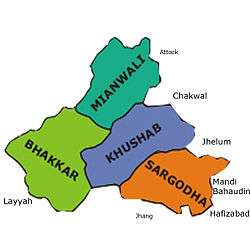Korey Koot
| Korrey Kot Ranjha کوڑے کوٹ | |
|---|---|
| Village | |
 Korrey Kot Ranjha Location in Pakistan | |
| Coordinates: 32°11′18″N 73°01′43″E / 32.18833°N 73.02861°ECoordinates: 32°11′18″N 73°01′43″E / 32.18833°N 73.02861°E | |
| Country | Pakistan |
| Province | Punjab |
| District | Sargodha |
Korey Koot is a village of Pakistan in district Sargodha near Tehsil Kot Momin. Its population is about ten thousand. Korrey and Koot were two ancient tribes who lived in this village centuries ago. Legend has it that the village was inundated by river Chenab as it used to flow by the village then. Ranjha رانجھا Dahar ڈار, Haral, and Gondal are the main tribes but Ranjha is the dominant and most numerous landowning tribe in the village. Village has a number of educated people who are serving the nation as teachers, lawyers, bureaucrats and progressive farmers etc. Korrey koot has fertile land and is well known for its kinno production. Majority of the population belongs to Sunni Muslim sect. Though this village has a large number of educated people yet they are still engaged in medieval-era-like turf wars. Demographically, the village comprises three major social classes, i.e. landowning class, landless peasants and kamis ---- those who do minor jobs. In fact, this village is a microcosm of the wider class based Pakistani culture.
Feuds and alliances against each other are common between the three leading families; the 'Numberdaars' or the 'lambars', as they are commonly called, are a family whose legacy is decaying; the 'Shahu-kai', an offshoot of the larger 'Jiwyana' family, increased their fame and influence after a son of theirs was appointed Commander of MI (military intelligence) for central Punjab; the third are the 'Alayarkays', the most pugnacious when it comes to their rivals and yet respected by the common peole, known for always fighting every sort of fight alone, is resurgent and amassing power seems to be their plan before they strike their enemies for good.
Moreover, shrine of Baba Shah Manzoor, a famous mystic who is said to have gone under the earth alive along with a female follower, is also located in this village. Shah Muhammad Muslim Sheikh, a famous folk singer, was also born in this village. And Ahmed Wadhan, a local poet, wrote an epic poetry--Punjabi waar (waar is a Punjabi term for war)--over a long series of fights between two families, i.e. Allahyarka and Nambardar families. Main characters of waar are Ahmed Bukhsh Ranjha (from Allahyarka family) and Muhammad Yar Ranjha ( from Nambardar family). Until recently this Punjabi waar used to be sung in local gatherings but due to busy pace of life nobody finds time to organise such events any longer. Though the families have reconciled their differences to a great extent yet the memory of their decades long animosity is still fresh in people's minds through Ahmed Wadhan's poetry. In fact, this waar is a great source of korrey koot's cultural and political history. Apart from this, the village is just five Kilometers away from Takht Hazara, a village, where Dheedhu Ranjha the most famous character of "Heer Ranjha" story was born. Likewise, Bhehra, the first line of defence of Mughal and Sultanate dynasties of India against foreign invaders such as Greek and Persians, is also a few kilometres away from the village. So, "Alexander the Great "and Nadir Shah of Iran must have passed by the village when they invaded India but no claim to the resistance of locals to foreign invaders can be made due to unavailability of historical record.
